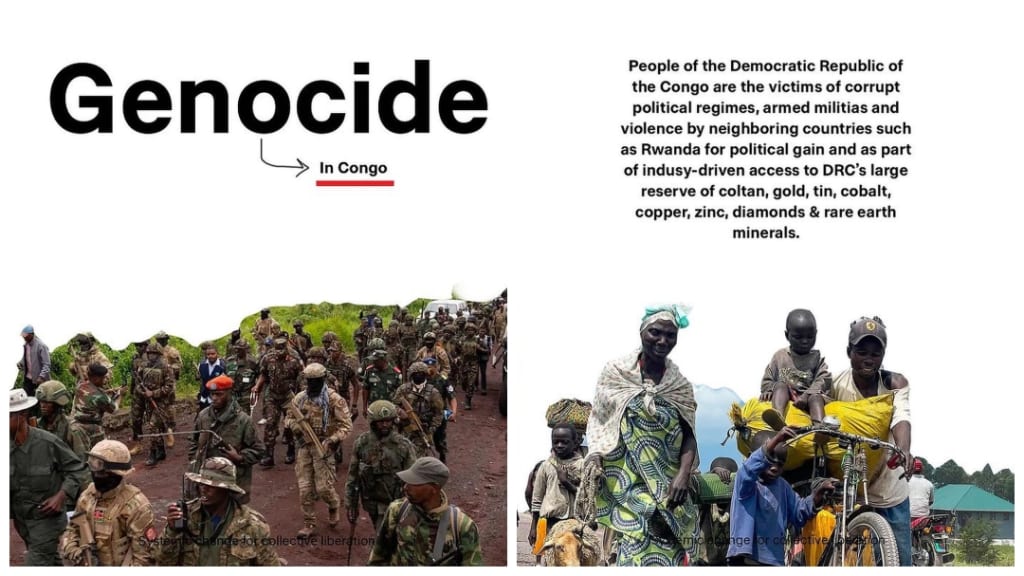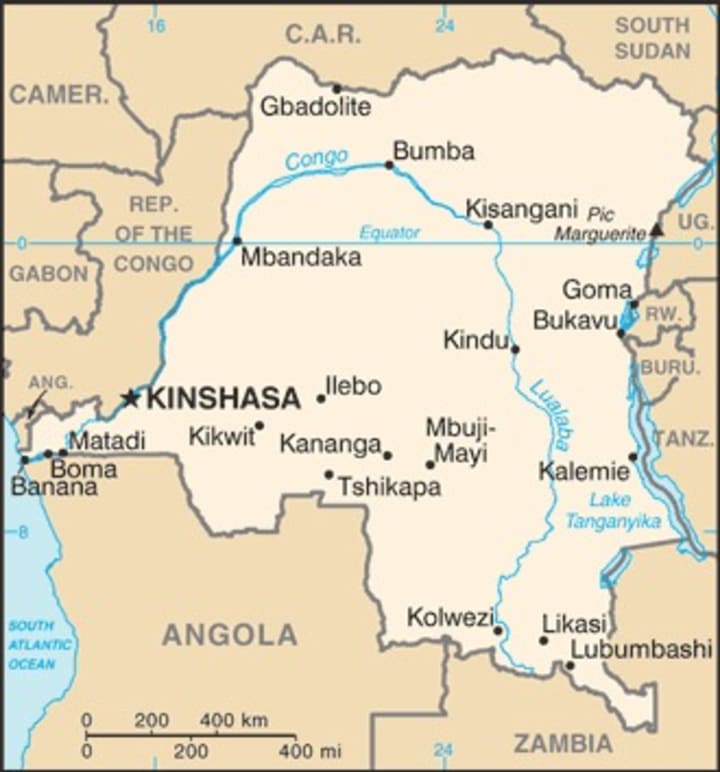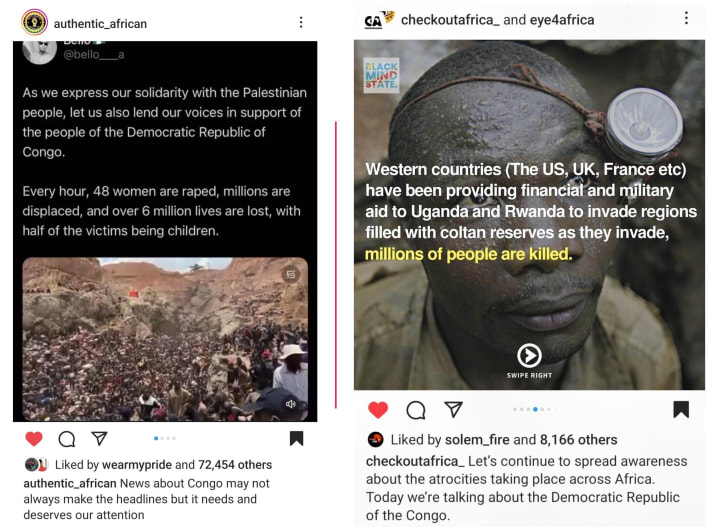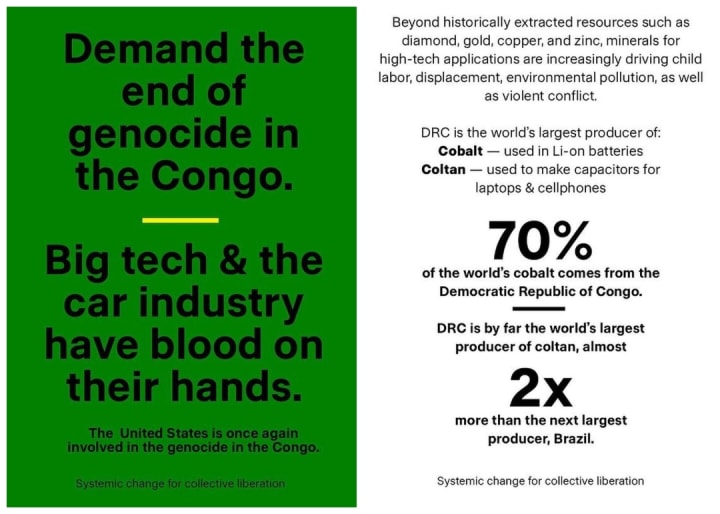Silent Genocide in the Heart of Africa: The Congo
“News about Congo may not always make the headlines but it needs and deserves our attention.” – authentic_african, via Instagram

Since 1996, the Democratic Republic of Congo (DRC; Congo) has been embroiled in violence that has killed as many as 6 million people. The conflict has been the world’s bloodiest since World War 2. Although people of the DRC are among the poorest in the world, having the fifth lowest GDP per capital globally, the DRC is widely considered to be the richest country in the world regarding natural resources that comes from the Congo’s soils. With untapped deposits, the raw materials that naturally comes from the Congo is estimated to be worth more than US $24 trillion. Gold, diamonds, cobalt, and zinc are among the natural resources that are found in the Congo.
The First and Second Congo Wars, which sparked the violence, involved multiple foreign armies, ad hoc militia groups, and investors from Rwanda, Zimbabwe, Angola, Namibia, Chad, Libya, Sudan, and others. This has been so devastating that it is sometimes referred as the “African World War.” The fighting continues in the eastern parts of the Congo, destroying infrastructure, causing physical and psychological damage to civilians, and creating human rights violations on a massive scale. Rape is even being used as a weapon of war, and large-scale plunder and murder are also occurring in efforts to displace people from their resource-rich land.
“The fourteenth-century empire of Kongo (which Europeans referred to as the greatest state in West Africa at the time of their arrival).” – Dr. Walter Rodney, author of How Europe Underdeveloped Africa
The Prosperous Kongo (Congo) Empire during Medieval Times

The Kongo Empire stretched far north as present-day Gabon, and as far south as present-day Angola. The empire covered a vast region in southwest and central Africa, precisely 300,000 square kilometers. It is debatable whether one single law dominated the entire region, but a single civilization predominated.
The Portuguese were the first Western Europeans to reach West Africa, and they arrived at the mouth of the Great Kongo River in 1488. When the Portuguese entered the Kongo, to their great surprise, they didn’t expect the political structure and expertly organized administrative machinery equaled that of Portugal or any other European country known to them. The Kongo’s economic system of agriculture and handicraft industries, organized into guilds, was the same; apprenticeship training for all skilled occupations was the same; and the general pattern of social organization was also the same as other African societies during medieval times. The Kongo was prosperous, carrying on external trade by both land and rivers with African countries farther north, east, and west.
An abundance and variety of agricultural products were grown in Kongo. For instance, there were crops of bananas, cauliflower, coconuts, cola, citrus fruits, cucumber, palms of various varieties – including date palms, pineapples, plantains, rice, watermelons, yams, and many others. Other grains were imported from Egypt by an overland route. In addition, other agricultural produce of American origin was imported via the Portuguese. Built on their agricultural industries, the Kongolese produced oil, wine, vinegar, and bread. From wild palms, the Kongolese made mats, baskets, and other articles of everyday use. Furthermore, their houses were typically made of tightly interlaced palm branches, divided into convenient rooms, and thatched. The most revered profession in Kongo was that of the ironsmith. They typically forged knives, weapons, axes, and hoes. They also forged copper products and made bracelets using the celebrated lost wax technique.
Portuguese sources gave a bright picture of Kongo life. For example, the capital city of San Salvador (i.e., Mbanza Kongo), was advantageously situated on the mountain in the country. This offered a natural defense and gave a panoramic view of the empire. The king of Kongo was Dom João I (i.e., Nzinga a Kuwu), and he raised thick walls, one mile in circumference around his royal palace and royal houses. He even had an area of similar size that was reserved for the Portuguese and was also walled. The doors of the aristocratic homes faced the walls of the church, as did the homes of the Portuguese. Outside of the enclosures stood numerous buildings that belonged to various lords.
The smallest political unit was the village, typically characterized by matrilineage. The head of each village seems to have been hereditary. Above the village level were districts. Headed either by royally appointed officials or by provincial governors, they performed administrative duties and served as judges. All titleholders bore the title of Mani (i.e., lord) followed by the name of their province, district, or their function. The government derived its income from taxation and labor. Tribute was paid in raffia cloth, ivory, hides, slaves, and tolls.
Brightly colored nzimbu shells were the currency. These came from the island of Luanda and were typically mined and graded into size by Black women of the Kongo. Size dictated the relative value of each shell. Government income was used to grant gifts to the titleholders at court and also to the territorial rulers. The taxes were paid once yearly at a ceremony in front of the king’s palace. All territorial officials would come and bring their produce from their locality. They would also renew their oath of loyalty to the Mani Kongo. At this point, the Kongo king could remove incompetent officials if he decided to do so.
Kongolese King Dom João I was King Nzinga a Kuwu’s Portuguese name, which he changed when he became baptized in (Western) Christianity. To become a Christian, one had to be baptized and given a “Christian” name, according to the Portuguese missionaries. The first Kongo king to become Christian was King Nzinga a Kuwu in 1492. Hundreds of other Black people followed the king’s lead, such as princes, chiefs, ministers, and some of the masses. The most notable Kongolese kings became “Black Portuguese,” and their names changed, and they became known as “Alfonzos,” “Alvares,” “Dom Pedros,” “Diogos,” etc. Even the king of Portugal himself addressed the king of Kongo as “brother.”
The Fall of the Kongo Empire and the Transatlantic Slave Trade
On the authority of Dr. Chancellor Williams, author of The Destruction of Black Civilization: Great Issues of a Race from 4500 B.C. to 2000 A.D. When (Western) Europeans came to west, southwest and central Africa, their aim was to change Black people into Christians. Dr. Chancellor Williams said it was the Blacks own fault for allowing this to happen because when Black kings and their followers chose to embrace (Western) European names, they rejected and became ashamed of both their culture and everything that made them African people. Blacks are the only people in the world who have done this. So, when the Portuguese missionaries began their work on converting kings and nobles of the Kongo to Christianity, it was easy, because the Kongolese were anxious for a new education and its vehicle was Christianity. The Portuguese priests found converting the Kongolese population to (Western) Christianity expediently easy.
Once the veil was lifted from the eyes of the Kongolese people, they no longer could deny the true intentions of the Portuguese. The Portuguese “Christianization” of the Kongo created nothing but utter chaos. It was a revolting mess of carnage. For example, the Portuguese priests were not only among the leading slave masters, but they also owned slave ships to carry the so-called “black cargoes” to distant lands in America.
The Portuguese priests were also in possession of “slave black girls,” and some of these European priests had as many as 20 each. They were called “house servants” by these so-called “holy fathers.” The slave situation became so dire that every white man down to the lowly worker became a slave trader. One of the main attractions of slavery, and the magnet that drew thousands of white men from Europe to Africa was their unlimited sexual freedom with all the Black girls and women they enslaved. Black girls and women were helpless during the Transatlantic slave trade era, because “wholesale raids” of white men on Black womanhood continued to increase the mulatto (i.e., Mixed Africans: Afro-European) population in Africa.
The Kongolese began opposing their kings and were fighting both slavery and the (Western) Christian Church that promoted slavery. In Kongo, the Transatlantic slave trade did not get under way without grave doubts and opposition from the king of the state of Kongo at the beginning of the 16th century. The Kongolese king asked for masons, priests, clerks, and physicians, but instead was overwhelmed by European slave ships sent from Portugal, and a vicious trade was opened by playing one part of the Kongo Empire against another.
Even the broader education that the Kongolese were initially excited about when they were approached by the Portuguese turned out to be a sham and a travesty. King Dom Alfonzo I of the Kongo, a Christianized son, succeeded his father Dom João I (i.e., Nzinga a Kuwu), and had made great efforts to get at least “one” good school established in Kongo by the Portuguese, but he was blocked. The Portuguese had no intention for any widespread education for the Blacks of the Kongo because this would mean the king of Portugal would have to send well-trained teachers to the Kongo.
“But even if Portugal had had the best intentions, she herself did not have many educated men in the sixteenth century and her own illiterate masses were just as ignorant as those in the rest of Europe.” – Dr. Chancellor Williams
These abuses the Kongo Empire was receiving from Portugal promoted a series of letters from King Dom Alfonzo I to the Portuguese court.
Alan Scholefield, author of The Black Kingdoms adds:
“More than twenty of Alfonzo’s letters to King Manuel (of Portugal) and his successor, King John III, survive, and very bleak reading they make.”
One such letter by King Dom Alfonzo I was dated June 6, 1526, and read:
“There are many traders in all corners of the country [wrote Alfonzo I]. They bring ruin to the country (of Kongo). Every day people are enslaved and kidnapped, even nobles, even members of the king’s own family.”
These pleas by King Dom Alfonzo I fell on deaf ears and enslaving continued in the Kongo. Moreover, King Dom Alfonzo I sent a gift of silver to Portugal in the 1520’s. This convinced the Portuguese that silver mines existed within the Kongo despite King Dom Alfonzo I assertions to the contrary. The Portuguese, however, believed that Kongo had an indigenous source of gold. It was these beliefs that led Portugal to continue their diabolical actions in the Kongo.
“Once trade in slaves had been started in any given part of Africa, it soon became clear that it was beyond the capacity of any single African state to change the situation.” – Dr. Walter Rodney
One must not also forget the brutality the Congolese people felt from Belgium and King Leopold II. It is estimated that King Leopold II exterminated 15 to 20 million Black people in the Congo. The Congo was a consistent source of wealth for Europe, and King Leopold II made at least $20 million from rubber and ivory that was extracted from the Congo. The root cause of the wars in Congo was by King Leopold II who was very adamant in “getting a slice of this magnificent African cake.”
These wars by Belgium in Congo were why Congolese Revolutionary and first president of a free and independent Democratic Republic of Congo, Patrice Lumumba was murdered.
When European nations “Scrambled for Africa,” they were fighting amongst themselves for different territories in Africa. The Berlin Conference from 1884-1885 is when 14 European nations met in Berlin, Germany; they got organized, and agreed amongst themselves that no African ruler shall be in power in Africa. At the Berlin Conference, not one African was present. It was at this conference where European nations agreed to stop fighting amongst themselves for the possession of Africa and African people. The decisions made at the Berlin Conference forever altered the lives of African people, which included those who were forcibly exiled to other lands as enslaved people in the American and European continent and those who were conquered and colonized in their own lands Africa (i.e., Belgian Congo, French West Africa, British Gold Coast, etc.).
The Genocide in Congo Continues…

A special mineral mined in the Congo is coltan. In 2021, the DRC’s coltan production amounted to an estimated 700 tons, making the DRC the world’s largest coltan producer. Coltan is an important resource used to manufacture all modern technical devices. The mineral is refined to tantalum powder, which is used to make heat-resistant capacitors in many electronic devices, such as laptops, cellphones, and other high-end electronic devices.
The human harms and child labor attached to mining coltan in the Congo is exploitative to the already impoverish communities. Observers have noted that coltan mining businesses rarely-compensate affected communities in the Congo by implementing development programs, which is a stationary requirement in terms of the mining laws. Much of the Congo’s coltan is extracted through the labor of over 40,000 child miners. They work in dangerous conditions as washers and diggers. Children doing adult work in a hazardous environment is beyond dangerous because the children face the risk of ill health, harassment, and abuse. They may even drop out of school or never have an opportunity to attend school.
Environmental activists in Bukavu confirm that coltan exploitation has led to the loss of trees, which is known to destroy ecosystems, decrease the carbon stock, disrupt the photosynthesis process, and affect air quality. It is also affecting wildlife habitats. The process of mineral separation and sorting is done manually through washing at streams and rivers. The chemicals used are polluting water bodies and are harmful to aquatic animals. The chemicals are also known to produce radioactive substances that are detrimental to human health.
Oluwole Ojewale, Regional Coordinator, Institute for Security Studies, for The Conversation said:
“The government must reform the Congolese Environment Agency to enforce environmental impact assessments and implementation of environmental management plans. Civil society organisations should train and equip observatory groups at the local level to monitor and report on coltan mining sites. This will provide a shadow report to compare with audits carried out by state agents.”

Several million people have died in Congo from the conflict that began in 1996. The death toll is due to widespread disease and famine; reports indicate that almost half of the individuals who have died are children under the age of five. The long and brutal conflict in the Congo has caused massive suffering for the population, with estimates of millions dead either directly or indirectly because of the fighting. There have been frequent reports of weapon bearers killing civilians and destroying property.
Those people who are not subject to violence must contend with poverty, and disease. Hundreds of thousands of people have been impoverished by the violence. Even child and mortality rates are extremely high because of famine and malnutrition. An estimated 4.5 million people have been displaced within the Congo, and 3 million Congolese have become refugees in neighboring African countries such as Burundi, Rwanda, Tanzania, and Uganda.
The war in Congo, just like the rest of Africa has always been about Africa’s precious resources and minerals, and in recent years, these wars have benefited Western (European) corporations. This special mineral known as coltan is the reason why cellphones, computers, tablets, video game consoles, etc. can work and function. Without coltan, these devices will become obsolete. Back in 2020, it was estimated that over 6.1 billion smart phones will be in circulation. Just smart phones, not computers or any other smart gadgets.
“Now you understand why Congo is in perpetual crisis. Imagine if the people of Congo united, living peace and they conducted trade with the rest of the world from the position of strength, wouldn’t Congo be one of the richest and most prosperous nations in the world?” – Tamunokuro Obietonbara, author of Rebirthing the African Consciousness

Sources:
authentic_african. News about Congo may not always make the headlines but it needs and deserves our attention. What did you guys think? Let us know in the comments. Follow @authentic_african for daily posts on African News, History, and Pop Culture. I need your help to keep creating free educational content! In order of impact, you can support my work by: - Saving this post (it really is a boost) - Sharing this on your story - Commenting one thought that sparked in your head - Tipping me on Zelle ([email protected]) or Cashapp ($AuthenticAfrican) - Of course, liking this post! Thank you so much, let’s continue to share History and stories from Africa and the Diaspora! authentic_african. Instagram. Nov. 3, 2023. Nov. 7, 2023. https://www.instagram.com/p/CzMZ5IMog4W/?igshid=bXM4azJqbWZ0bTY3&img_index=1
Browder, A. Nile Valley Contributions to Civilization: Exploding the Myths Vol. 1. The Institute of Karmic Guidance; First Edition. (Dec. 1, 1992). Nov. 7, 2023. p. 258-259.
checkoutafrica_. Let’s continue to spread awareness about the atrocities taking place across Africa. Today we’re talking about the Democratic Republic of the Congo. WHAT I NEED YOU TO DO. - Share this post. (CRUCIAL) - Save this post. (IMPORTANT) - Comment on this post. (GOOD) - Like this post. (APPRECIATED). @blackmindstate @checkoutafrica_. checkoutafrica_. Instagram. Oct. 26, 2023. Nov. 8, 2023. https://www.instagram.com/p/Cy3KgtiMfd0/?igshid=ZW55OHJzcndnMHpi&img_index=1
Merchant, Z., Michalopoulos, J. Democratic Republic of Congo. World Without Genocide. Oct. 2023. Nov. 7, 2023. https://worldwithoutgenocide.org/genocides-and-conflicts/congo
moyoafrika. Amplifying and connecting struggles is important in a world full of complex and interconnected systems of violence and exploitation. Political education is a key piece of collective liberation. ID: via @sf_access. Sources: @unitednations @humanrightswatch Reposted: @theslowfactory. moyoafrika. Instagram. Nov. 5, 2023. Nov. 7, 2023. https://www.instagram.com/p/CzRpS3oOh-N/?igshid=MWowY3MxZGtrOTM4MA%3D%3D&img_index=1
Obietonbara, T. Rebirthing the African Consciousness. Aquqo Press Limited. (Nov. 22, 2021). Nov. 7, 2023. p. 45, 92, 94-95.
Ojewale, O. What coltan Mining in the DRC costs people and the environment. The Conversation. May 29, 2022. Nov. 7, 2023. https://theconversation.com/what-coltan-mining-in-the-drc-costs-people-and-the-environment-183159
Rodney, W. How Europe Underdeveloped Africa. Verso. (Nov. 27, 2018). Nov. 7, 2023. p. 81, 91-92, 180.
Walker, R. When We Ruled: The Ancient and Mediaeval History of Black Civilizations. Black Classic Press. (May 1, 2011). Nov. 7, 2023. p. 343-348, 350.
Williams, C. The Destruction of Black Civilization: Great Issues of a Race from 4500 B.C. to 2000 A.D. Third World Press; 3rd Revised ed. edition. (Feb. 1, 1992). Nov. 7, 2023. p. 261-262, 264, 269-270, 274-275.
About the Creator
Darryl C. Richie
Inspirational Speaker, Author and Blogger looking to inspire with my story of being a two-time cancer survivor and hip amputee, and connect the African Diaspora to their African roots via Black Consciousness.






Comments (1)
This is amazing work you can join my friends and read what i have just prepared for you